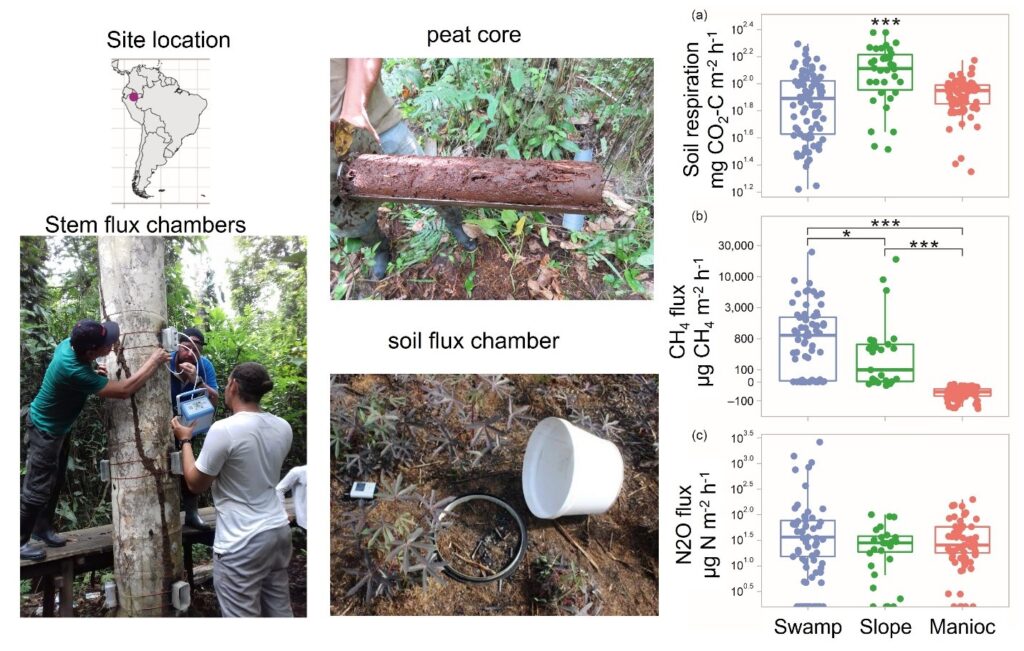Changing wetland soils in the Peruvian Amazon threaten global climate with more greenhouse gas emissions
The Science
Amazonian wetlands, including wet peatlands, are a major carbon and nitrogen sink but also sources of methane (CH4). Additionally, Peruvian rainforests are home to an impressive diversity of species, including 5% of globally known amphibians and 16% of butterflies. However, these ecological capacities are increasingly vulnerable to the impacts of global warming, droughts, and land use changes. The changes are turning the Amazonian peatlands to sources of dangerous greenhouse gases – carbon dioxide (CO2) and nitrous oxide (laughing gas; N2O). To better understand the environmental drivers of CO2, methane (CH4) and N2O fluxes in Peruvian peatlands across a wide range of land uses, an international team lead by Dr. Jaan Pärn and Prof. Ülo Mander from the University of Tartu, in collaboration wihh Dr. Robinson I. Negron-Juarez of Lawrence Berkeley lab, conducted a measurement campaign in Iquitos, the Peruvian Amazon. The campaign took place from the end of dry season in September 2019 to late rainy season in March 2020. The team investigated three sites:
- A pristine swamp forest in the Quistococha lake floodplain.
- A young secondary swamp forest grown on fallow pasture and banana plantation on an alluvial toe slope.
- A slash-and-burn manioc (Manihot esculenta) field.
The team measured CO2, CH4, N2O fluxes, denitrification (N2O and N2) potential from intact peat cores, and auxiliary environmental characteristics (soil temperature, water table, O2 and other chemistry) from the soil. In the pristine swamp forest, CO2, CH4, N2O fluxes were also measured from palm and Symphonia hardwood trunks.
The Impact
The peat swamp forests under slight water table drawdown emitted large amounts of both CO2 and CH4. Much of the CH4 was released through palm trunks, which is a novel addition to current knowledge. A heavy post-drought shower created a hot moment of N2O in the pristine swamp forest. The analysis revealed nitrifiers – a group of soil microbes – as responsible for the N2O production. Several indirect signs of temporary oxygen intrusion in the swamp forest soil were noticed, facilitating the aerobic microbes. The manioc field, in no surprise, emitted relatively high amounts of CO2 and N2O.
Summary
Peruvian Amazonia is a global sink of carbon but a hotspot of CH4 and N2O emissions. With an objective to identify environmental drivers of CO2, CH4 and N2O fluxes of Peruvian wetland soils under a broad range of land use, an international team lead by Dr. Jaan Pärn and Prof. Ülo Mander from the University of Tartu and involving Dr. Robinson I. Negron-Juarez of Lawrence Berkeley lab held a measurement campaign in Iquitos, the Peruvian Amazon. The investigation showed that even small changes in soil moisture can create ‘hot moments’ of GHG emissions from microbes in Amazonian wetland soils, and should therefore be carefully monitored.

Figure. The left figure shows the site location and experimental design. The right figure shows carbon dioxide (CO2), methane (CH4) and nitrous oxide (N2O) fluxes in from the Peruvian wetland soils, and their box plots. Significant differences according to Wilcoxon test are shown with asterisks as follows: * – p<0.05; ** – p<0.01; *** –p<0.001. Asterisks directly above box without brackets denote significant difference from all other sites in the plot. Images: courtesy of Jaan Pärn. Peat core image: Anna Macphie, Uni. St. Andrews
Contact: Jaan Pärn (University of Tartu), jaan.parn@ut.ee
Funding
The study was supported by the Estonian Research Council (PRG352 and MOBERC-20 grants) and the EU through the European Research Executive Agency (HORIZON-WIDERA Living Labs for Wetland Forest Research Twinning project No 101079192), European Regional Development Fund (ENVIRON and EcolChange Centres of Excellence, Estonia and the MOBTP101 returning researcher grant by the Mobilitas Pluss programme), the European Social Fund (Doctoral School of Earth Sciences and Ecology), LIFE programme project “Demonstration of climate change mitigation potential of nutrients rich organic soils in Baltic States and Finland” (LIFE OrgBalt, LIFE18 CCM/LV/001158), Czech Science Foundation (17-18112Y), and project SustES – Adaptation strategies for sustainable ecosystem services and food security under adverse environmental conditions (CZ.02.1.01/0.0/0 .0/16_019/0000797).
Dr. Negron-Juarez was supported by the Next Generation Ecosystem Experiments – Tropics funded by the U.S Department of Energy, Office of Biological and Environmental Research
Publication: Parn et al. “Effects of Water Table Fluctuation on Greenhouse Gas Emissions from Wetland Soils in the Peruvian Amazon”, Wetlands, 43:62 (2023). https://doi.org/10.1007/s13157-023-01709-z.